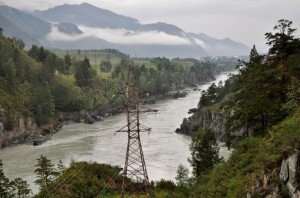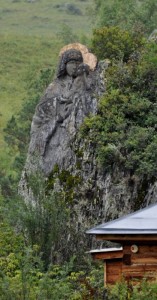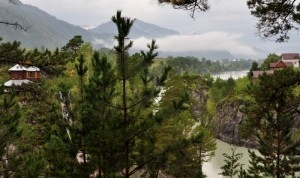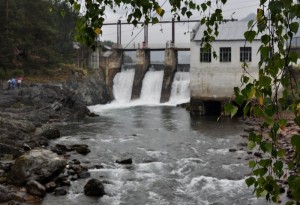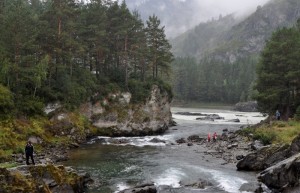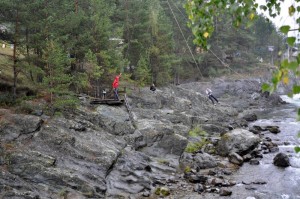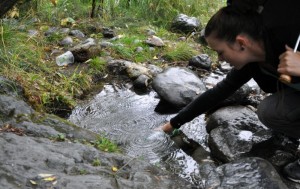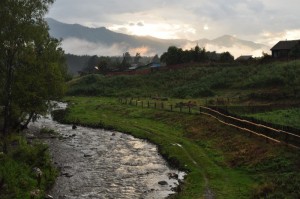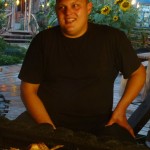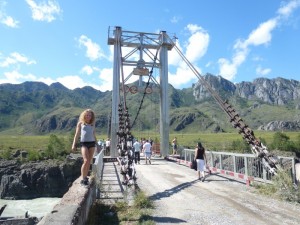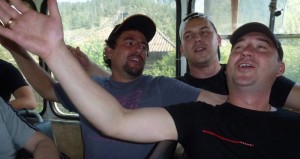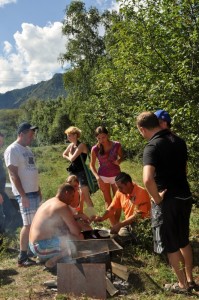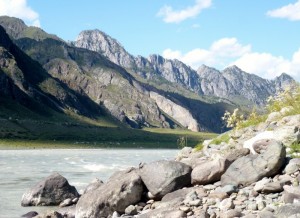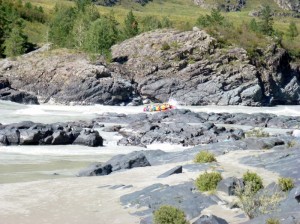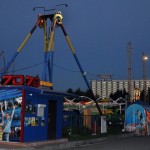I first learnt about the beautiful Altai Mountains from Roech’s paintings while passing through Novosibirsk in September 2010. As my month long Russian tourist visa expired on August 19, I could only make a brief visit to Chemal on my way to Kyrgyzstan. The scenery is stunning and I plan to take a trekking trip in the Altai Mountains one day.
Altai Mountains
The Altai Mountains are a mountain range in Central Asia where Russia, China, Mongolia and Kazakhstan come together, and where the rivers Ob and Irtysh have their sources. The Altai Mountains are known as the original locus of the speakers of Turkic as well as other members of the proposed Altaic language group.
This region is studded with large lakes and traversed by various mountain ranges. A vast area of 16,178 km² – Altai and Katun Natural Reserves, Lake Teletskoye, Mt.Belukha (the highest peak in Siberia and the Altai Mountains at 4,506m) and the Ukok Plateau – comprise a natural UNESCO World Heritage Site entitled “Golden Mountains of Altai”. This region represents the most complete sequence of altitudinal vegetation zones in central Siberia, from steppe, forest-steppe, mixed forest, subalpine vegetation to alpine vegetation and is also important for the preservation of the globally endangered mammals, such as snow leopard and the Altai argali.
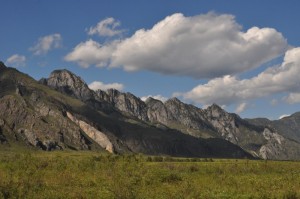 The Altai Republic
The Altai Republic
The Altai (also spelledAltay) Republic has an area of 92,600 square kilometres and a population of 206,168 (2010 Census). The most striking geographical aspect of the Republic is its mountainous terrain embracing a complex series of ranges and high plateaus, divided by deep valleys and broad basins. Steppe vegetation in the basins gives way to dense coniferous forest on the mountain slopes.
The republic was formed as an autonomous oblast in 1922 for the Mongol Oirat people, for whom it was named until 1948. Gorno-Altaysk is the capital of the Republic. About two-thirds of the inhabitants are Russian. The economy is largely agricultural. In the valleys oats, other grains, and vegetables are grown, but the raising of cattle, sheep, goats, horses, and yaks on the mountain and valley pastures is dominant. Fur hunting and timber working are also carried on.
The Altai region is fast becoming a tourism destination for both Russian and overseas tourists. Some of the more well-known tourist spots include Lake Aiya (a popular bathing spot) and the picturesque Chemal region. More adventurous travellers with time make their way to the more remote Lake Teletskoye or Mount Belukha in the south.
August 14, Monday: Novosibirsk –Chemal (460km)
After a good rest at the River Park Hotel in Novosibirsk, I got up before 7am, went to the bus station at 8am and got a ticket to Chemal. The bus departed at 11:15am but I did not arrive at my hotel till 9pm.
It was a dark and wet when I stepped off the bus. The hotel looks like a modern but tasteless soviet resort. The receptionist did not speak English and showed me to my room in a pre-fabricated block made of steel boxes. I did not like the hotel.
August 15, Wednesday: Chemal
I got up earlier and the sky looked grey. Breakfast started at 9am and the restaurant looks like a canteen. I was given a small bowl of porridge and two cold buns. I paid 2000 rubles a night for poor service. What a rip-off!
I finally managed to find someone who speaks English. He introduced me to a local travel company. Nadya arranged a trip for me with four Russian tourists. At first, she said it would be a short trek to a waterfall. Later it turned out to be an excursion to Chemal to see the Bogoslavski Chapel and a hydroelectric power station.
The tiny wooden Ioanno Bogoslavski Chapel re built in 2001 to the original 1849 design, is located on a craggy island in the Katun River. The island is connected to the mainland by a pedestrian suspension footbridge. The small canyon looks picturesque. Beside the chapel is a rock shaped like a Madonna-and-child sculpture which is supposedly natural.
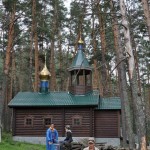 |
Nadya then took us on a narrow but well-trodden footpath winding high along the Katun riverbank into the VarotaSartikpayev Canyon, an important place within Altai mythology. The Chemal River with green water flows into the milky Katun River here.
After walking for about 15 minutes, we arrived at a small 1935 dam of the Chemal hydroelectric station. There are several platforms for bungee jumps or ‘fly’ across the Chemal River for 300 rubles. Nadya took us to see two springs, one with silver and other with iron. The water is said to be good for one’s health and is drinkable. I filled my bottle and found the water refreshing and cool.
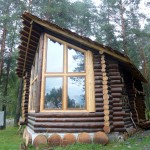 |
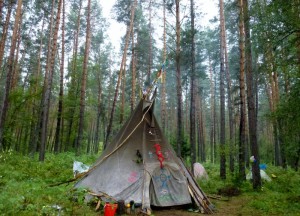 |
I was back to the hotel at 1pm and spent the afternoon selecting and cropping my Kamchatka photos. When the rain stopped, I took a walk to see a nearby village across the river before having a delicious dinner at a local restaurant recommended by Nada. I like the decoration of the restaurant and the guest house which is all in wood. I met the owner Alex who speaks some English. I like the place and stayed there for the last two nights (1500 rubles a night).
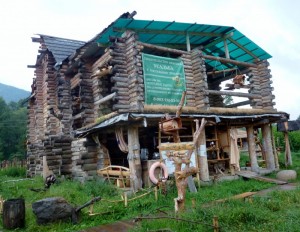
|
August 16, Thursday: Water rafting on Chemal River
I was thrilled to see blue sky and nice weather as I would have water rafting on Chemal River today. It cost me 1200 rubles. I however did not know when it would start. Nada said they would pick me up at 12:30 pm. At 11:30am, a guy came up while I was sitting by the river doing my travel notes and told me to leave with a guide immediately.
I was dropped off at 11:45am at the road side and told to get on a truck bus with a huge rubber raft on its top. It was a sunny day and I sat in the sun for half an hour. Then I went back to the bus to read. It was 1pm and no soul turned up though two more vehicles with rubber rafts on their roofs arrived.
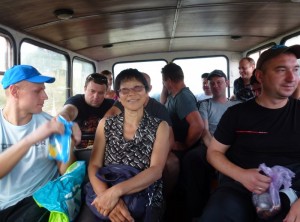 |
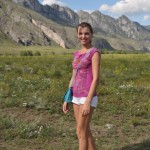 |
I was puzzled and upset as I did not know what was happening. Finally Marina from the tour company turned up. There seemed to be some communication problem and she did not know I was waiting since 11:45pm. Finally I met the rafting group – 29 Russian executives from Pepsi Cola who had just finished their team-building seminar.
I had one of the funniest moments of my whole trip. As I was frustrated and hungry, I decided to buy 1-litre bottle of Coca-Cola (I had never done this before). When the Russians saw me drinking my coke, they told me to throw it away as they worked for Pepsi Cola. I thought they were joking. Then one of them took my bottle, tore off the label and put on a black lid instead. I thought they tried to be funny. Then Mariana confirmed they are staff of Pepsi Cola.
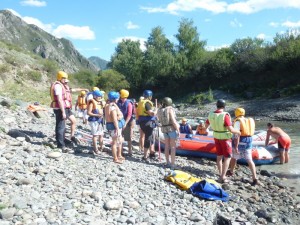 |
The group had a light lunch by a stream. The fish soup was delicious. Then we started rafting after 4pm for 30km. There are half a dozen of rapids which are not ferocious and dangerous. We arrived safely at our destination around 6pm. The sun was setting and it got cold in the shade. I wished they had started an hour earlier so that we could enjoy the warm sun, the stunning scenery and leisure rafting.
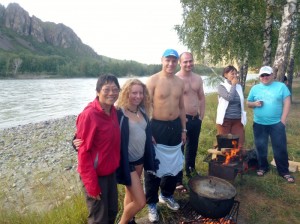 I have met many Russians through work who often look solemn and tense. I have never met such a lively, funny and noisy group before. A few of the men were laughing and singing all the way (I guess they had been drinking for a while). They have beautiful and powerful voices thus making their singing bearable! A few were particularly playful and naughty. They kept throwing water at us. A guy suddenly jumped from his raft onto ours and got one of our team members into the water!
I have met many Russians through work who often look solemn and tense. I have never met such a lively, funny and noisy group before. A few of the men were laughing and singing all the way (I guess they had been drinking for a while). They have beautiful and powerful voices thus making their singing bearable! A few were particularly playful and naughty. They kept throwing water at us. A guy suddenly jumped from his raft onto ours and got one of our team members into the water!
They then had a party by the river. I was given two small cups of vodka and a nice bowl of soup. They are wonderful and I really enjoyed my day! Marina dropped me off at the guesthouse.
August 17, Friday
I would like to visit the famous seven Karakol Lakes. But it was raining and cold. As there was no group departure, I had to stay at the guesthouse the whole day. Time however passed quickly and I spent some ten hours sorting out my photos.
August 18, Saturday: Chemal – Novosibirsk (460km)
The bus departed at 11:30am and I arrived at the bus terminal at Novosibirsk at 8:45pm. It was a long and tiring drive.
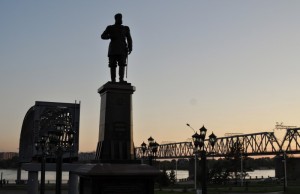 |
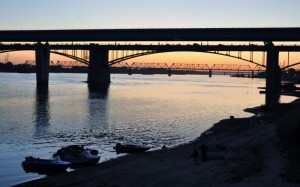 |
August 19, Sunday: Novosibirsk, Russia – Bishkek, Kyrgyzstan
I had a nice brunch and departed for airport at 10am. The flight took off on schedule and I arrived in Bishkek at 2:15pm.
Remarks
This is my longest stay in Russia with 22 days spent in Kamchatka and 4 days in the Altai region. In my view, Kamchatka, Lake Baikal and the Altai Mountain are the three best destinations in Russia for nature-lovers. I would like to spend more time exploring these three places.
One interesting discovery is about the people. There are often misconceptions and unfavourable views about Russians. They are seen as heavy drinkers, aloof, rude and difficult to fathom. Anyway, the Russians I met during this trip are common people and they are nice and friendly. I particularly like the way they take care of their garden and grow vegetables in their backyard. They might not be communicative and aloof due to the language barrier. They also have their own ways in doing things and might not be flexible. But they are genuine and straight forward. I like Andrey of the Kamchatka Lost World who has been efficient and helpful.


